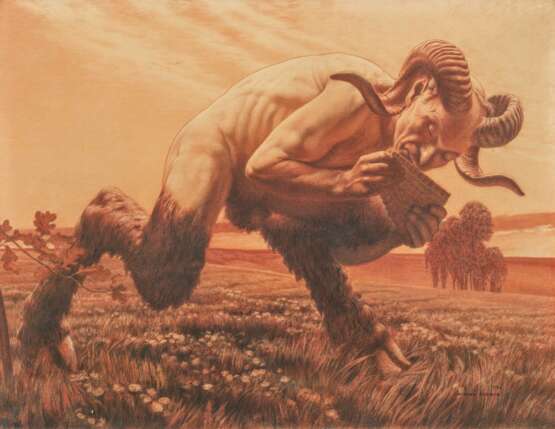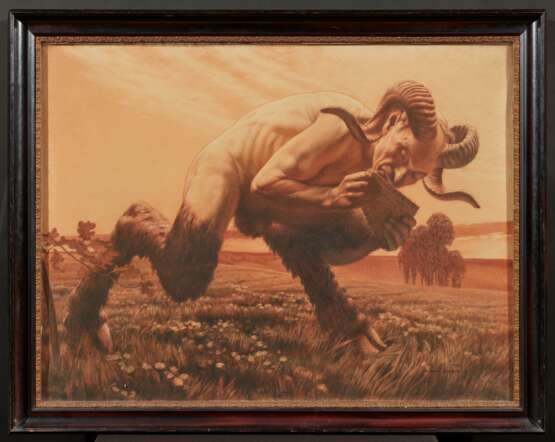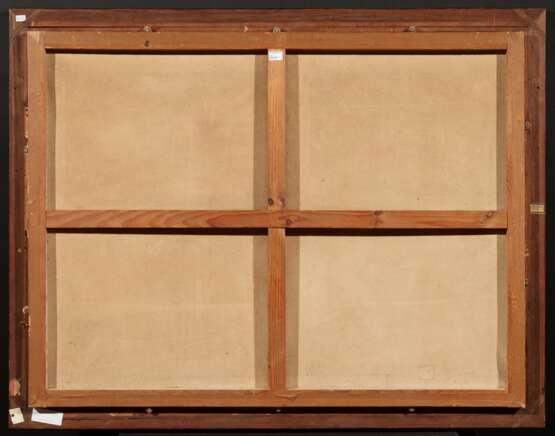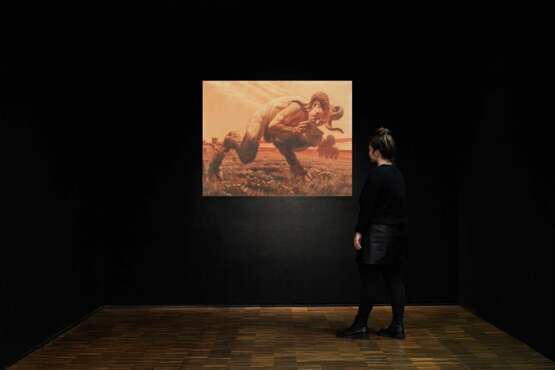ID 1208158
Lot 1175 | Carlos Schwabe. L'heure du faune
Valeur estimée
€ 20 000 – 30 000
Title: "L'heure du faune".
Date: 1920.
Technique: Red chalk and black chalk on paper.
Mounting: Laid down on canvas.
Measurement: 110 x 145cm.
Notation: Signed and dated lower right: "1920 / Carlos Schwab".
Frame: Framed.
Provenance:
Alarik d'Ornhjelm (Ombra d'Ornhjelm's brother, the artist's second wife);
Private ownership, Germany.
Exhibition:
Geneva, Galerie Moos, Carlos Schwab, 1920, no. 26 (as "L'heure du faune");
Paris, Galerie Georges Petit, Exposition rétrospective Carlos Schwab, 1927, no. 47 (as red chalk drawing and possessed by Alarik d'Ornhjelm).
Literature:
L. Dunand: Carlos Schwab à Genève. In: Tribune de Genève, 24th March 1920.
Vastly, primevally and terrifyingly close does it hurries past us. A faun as the drawing's title tells us. Very similar to the god Pan. He is absorbed by his playing of the flute. His eye lies on the instrument; so far he has not seen us. It is better this way, that he does not notice us. The reactions of such mythological creatures rarely are predictable.
The summerly landscape that the creature is roaming lies peacefully in front of us. The terrain slightly slopes twoards the horizon. One group of trees in the middle ground and one young oak tree at the left side of the mage are the only land marks in these swaying, blooming grassscapes. The human-like upper body of the Faun is showing bare skin until the middle of the thighs. His lower extremities are hairy and end in cloven hooves, corresponding to the ram's horns on his head. The hairy testicles of the creature are visible and, on closer inspection, the phallus in the thicket of his crotch. In the arcadic nature, the faun represents rampant desire, virility and lust and is comprehended in his full corporeality from this perspective.
Carlos Schwabe (also Schwab) who created this impressive work has chosen the sensual faun multiple times as his motif. Verifiable for the first time we meet the faun in a bent-over position 1905/1908 as marginal figure in a book illustration. There, however equipped with a sheepshead, he is watching the armorous play of a young couple and accompanies the scene by playing the pan flute.
The present work dated to 1920 presumably is the first version, in which Schwabe is presenting the faun as an autonomous, format-filling figure. He features him as an already aged creature, with one last remaining bright streak of hair on his otherwise bald head. The artist is depicting the mythical guy as younger once more in 1923. A smaller version within the art trade and another one, which is similar in size to the present work, feature the faun with thick dark hair who is hurrying through a completely tree-less corn field. Faun, Pan and the female equivalents, the nymphs and naiads were often depicted as primeval wild creatures across all artstic genres in the 19th centruy - specifically in the Symbolism. Because of his "fabulous", intangible being, his position as a heramphrodite and his compulsive nature, the faun was repeatedly depicted by artists of this genre. Amongst others Heinrich Füssli, Arnold Böcklin and Franz von Stuck have often painted fauns. In France, especially Stéphane Mallarmée's poem "L'après-midi d'un faune" published in 1876, its scoring by Claude Débussy (1894) and its performance as ballet (1912) by the "Ballets Russes" were known. Also the poet and art critic Tristan Klingsor published a poem under the titled "L'heure du faune" in Paris in 1913.
Carlos Schwabe was one of the most significant artists and illustrators of Symbolism in France. Born in Altona near Hamburg in 1866, he grew up in Geneva. After his education he travelled to Paris in 1884, predominantly worked in the area of applied art at first and designed tapestries, fabric patterns, and faiences. Soon Schwabe connected with a circle of symbolist painters, musicians and writers, designed posters from 1892 on. Schwabe became famous as an illustrator of books and magazines e.g. for Emil Zola, Maurice Maeterlincks or Charles Baudelaire. However, Carlos Schwabe also created autonomous art works. Repeatedly, he exhibited his art in the salon of the "Société des Beaux arts"; he represented Switzerland at the Paris world exhibition in 1900 and was honoured with a gold medal for his work. In 1901 he was appointed a member of the French Legion of Honour in recognition of his artistic work.
This late work of Carlos Schwabes is an exceptionally large-format red chalk and chalk drawing. The reduced colours seems to heighten the intensity of what we can see, an effect that is known from some grisailles or especially accomplished black-white photographies. The brilliant illustrator Schwabe demonstrates his absolute expertise with reduced means. Is there a whiff od malncholy in the faun's playing of the flute as he is walking through the meadow in the low sun? The faint mist that is covering the landscape and the velvet surface that are essential for the whole drawing convey conssumate harmony, in which this original creature is living with the surrounding nature.
| Artiste: | Carlos Schwabe (1866 - 1926) |
|---|---|
| Catégorie maison de vente aux enchères: | Aquarelles et dessins |
| Artiste: | Carlos Schwabe (1866 - 1926) |
|---|---|
| Catégorie maison de vente aux enchères: | Aquarelles et dessins |
| Adresse de l'enchère |
VAN HAM Kunstauktionen GmbH Hitzelerstr. 2 50968 Köln Allemagne | ||||||||||||||
|---|---|---|---|---|---|---|---|---|---|---|---|---|---|---|---|
| Aperçu | |||||||||||||||
| Téléphone | +49 221 92586215 | ||||||||||||||
| Fax | +49 221 92 58 62 4 | ||||||||||||||
| Commission | 32% | ||||||||||||||
| Conditions d'utilisation | Conditions d'utilisation | ||||||||||||||
| Heures d'ouverture | Heures d'ouverture
|







